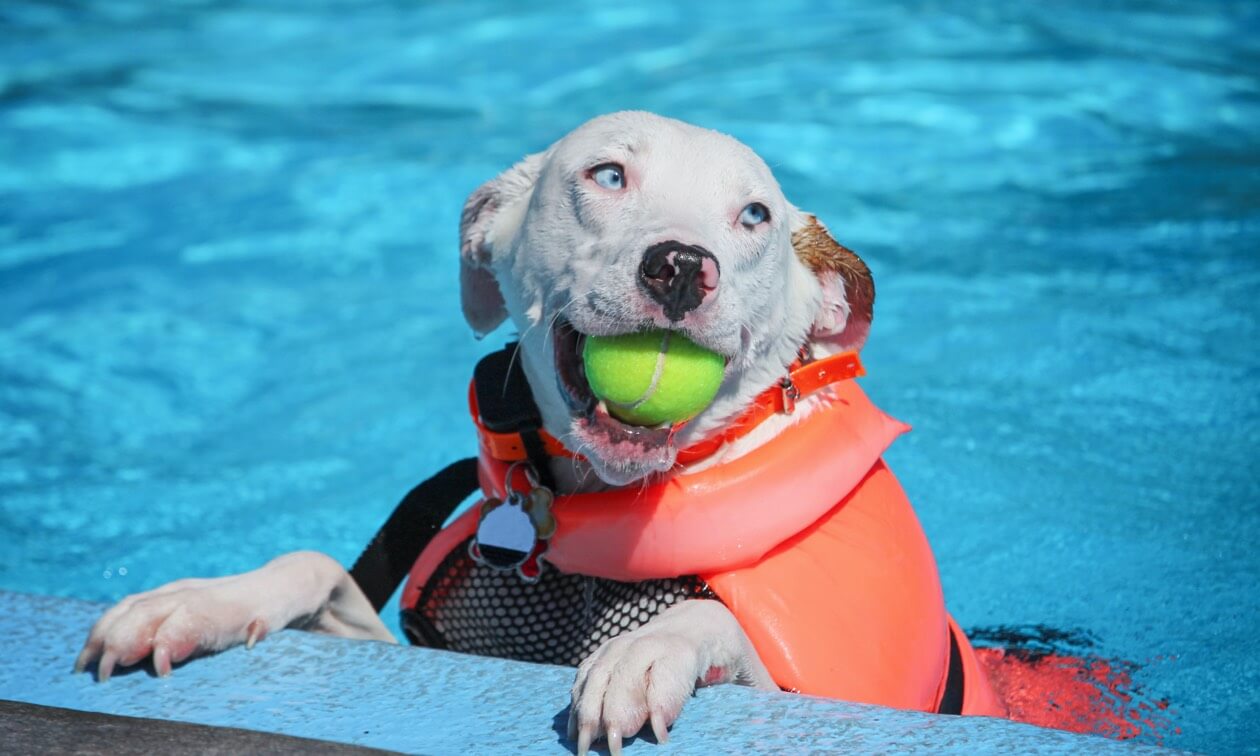Most people would agree that there’s nothing quite as refreshing as a dip in a pool on a hot day. Did you know some dogs feel the same way? Swimming is a low-impact exercise that helps condition dogs and improves their range of motion without stress on their joints. And it’s fun! But being around the pool has risks, even for good dog swimmers (and just because they like the water doesn’t mean they know how to swim). You need to take safety precautions to keep your dog safe in and around swimming pools.

How To Save A Drowning Dog
There is nothing more terrifying than finding your dog unresponsive in a pool. But you must remember to stay calm and take action.
These are the steps to follow:
- Clear the Airway of Water
For small dogs and puppies, hold them upside down so water can drain from the lungs. Large dogs should be laid on their side as you try to elevate the body above the head so water can run out the mouth and nose. - Check for a Pulse
Place two fingers on the inside of the upper part of the rear leg or listen for a heartbeat by placing your ear on their chest. You may have a hard time finding a pulse or hearing a heartbeat on overweight dogs. - If There Is a Pulse but No Breathing
Extend the dog’s neck to open the airway. Close their mouth and cover their nose with your mouth. Breathe into their nose until you see their chest rise. Continue until your dog is breathing on their own. - If There Is No Pulse
Attempt CPR on your dog.
If it can be done safely, attempt resuscitation while someone is transporting you to a veterinary hospital.
Near-Drowning of Dogs in Pools
Near-drowning, also called secondary-drowning, occurs when a dog has inhaled enough water to affect the gaseous exchange in the lungs but not enough to cause drowning. Even if a dog seems to cough up the water or you observe water running out of their mouth or nose, some water may remain in the lungs, often resulting in pneumonia. This form of drowning can occur up to three days after the event.
Following a near-drowning event, it’s important to monitor your dog, even if they seem fine. Symptoms of near-drowning include:
- Difficulty breathing
- Coughing
- Lethargy
- Pale gums
- Abnormal heart rate
- Abnormal respiratory rate
- Collapse
Due to the lack of oxygen, symptoms typically progress quickly. Therefore, any time you suspect your dog has inhaled water, it’s important to have them evaluated by a veterinarian.
Is It Safe for Dogs to Ingest Pool Water and Chemicals?
Having a pool can put your dog at risk of being poisoned. Ingesting too much pool water causes water intoxication, and they can also be poisoned by ingesting pool chemicals.
If your dog ingests too much pool water, the sodium levels in their blood will drop dangerously low. Even though this is a rare situation, it can be fatal if not treated immediately. Salt poisoning can occur if too much water is ingested from saltwater pools.
Signs of water intoxication include:
- Bloating
- Nausea
- Vomiting
- Lethargy
- Dilated pupils
- Loss of coordination
- Drooling
- Seizures
Signs of salt poisoning include:
- Vomiting
- Weakness
- Muscle tremors
- Seizures
Once pool chemicals, such as chlorine tablets, brominating tablets, and muriatic acid, are diluted in a pool, they’re generally not a concern. Typically, the most common side effect from ingestion of chemicals in the pool water is nausea and vomiting. However, if they’re ingested undiluted, such as your dog finding and eating the tablets, they are poisonous. They can cause ulcers in your dog’s mouth, throat, esophagus, and intestines which can result in intestinal perforation.
You can prevent toxicity by taking these steps:
- Provide plenty of fresh water away from the pool.
- Supervise to ensure they are not drinking pool water. Frequent potty breaks are a good clue.
- Keep all pool chemicals in chew-proof containers in a locked and secure location.
- Keep dogs secured and away from open chemical containers when performing pool maintenance.
If you suspect your dog has water intoxication, salt poisoning, or poisoning from pool chemicals, seek medical care immediately.
Can Pool Water and Chemicals Irritate Your Dog’s Skin, Ears, and Eyes?
For dogs who just love to swim, exposure to the chemicals in the pool water can cause skin irritation like redness, dryness, itching, or flaking. The subsequent chewing and scratching can lead to a skin infection and a visit to the veterinarian.
The coat can become dry and dull since the natural oils are stripped away. Dogs with dark coats may experience mild bleaching of the fur, and those with light-colored coats can turn greenish.
When your dog gets out of the water, you may notice their eyes are red. Depending on the level of discomfort, they may rub their eyes with their paws or on a carpet which can cause trauma.
Water left in the ears can lead to ear infections, meaning another trip to the veterinarian.
Take these simple steps to avoid skin, coat, eye, and ear irritation:
- If you notice an immediate reaction after swimming, keep your dog out of the pool.
- Closely monitor the chemical levels of the pool water.
- Before swimming, apply a leave-in coat conditioner that contains sunscreen.
- After swimming, rinse them off with fresh, cool water and rinse their eyes with a sterile saline eyewash.
- At the end of a swim day and after baths, rinse your dog’s ears out with a dog ear cleaner containing cleaning and drying agents.
- For dogs with medium to long hair, reapply a coat conditioner following the last rinse of the day, massaging it into the skin and combing their fur to disperse the conditioner.
Drowning Dangers for Dogs in Pools
It doesn’t matter how well your dog swims; drowning is always possible. This tragedy can be prevented by taking a few precautions:
- Teach your dog to swim.
- Enclose your pool with a fence.
- Get a pool alarm system that will alert you to unexpected motion in the pool.
- Place motion sensors around the pool area.
- Install a solid pool cover that can bear some weight in an emergency.
- Get a pet-friendly pool ladder, ramp, or stairs, and train your dog how to safely get in and out of the pool.
- Avoid allowing dogs with mobility issues around the pool.
- Always have your dog wear a properly fitted life jacket with a handgrip when around and swimming in the pool.
ZPC-01816R1





